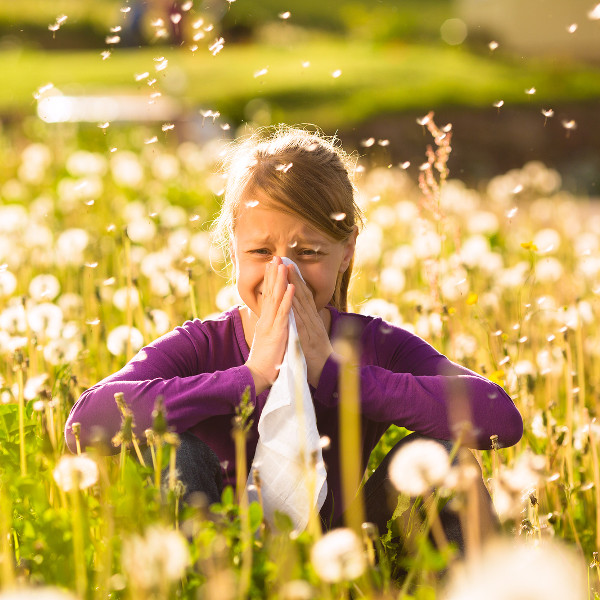Allergies plague millions of people every season with stuffy noses, red eyes and more. Some may be so beaten down by these symptoms they look for every way to help ease their suffering. When trying to find relief from you allergies during the pollen season knowledge is power. The more you understand how and why these allergies occur the easier it is for you to avoid your triggers and lessen your symptoms. Let’s take a look at some facts about pollen, how to avoid it, and treat pollen allergies.
What is Pollen?
Pollen is one of the most common triggers of seasonal allergies. Experts usually refer to pollen allergy as seasonal allergic rhinitis. Each allergy season, plants release tiny pollen grains to fertilize other plants of the same species. Most of the pollens that cause allergic reactions come from trees, weeds and grasses. These plants make small pollen grains that travel by the wind.
In fact, grasses are the most common cause of allergy. Ragweed is a main cause of weed allergies. Other common sources of weed pollen include sagebrush, pigweed, lamb’s quarters and tumbleweed. Certain species of trees, including birch, cedar and oak, also produce highly allergenic pollen. Even mold spores in high concentrations can give rise to the same symptoms as pollen.
We come into contact with pollen by breathing it in through the airways. It also becomes attached to the skin, hair and eyes. For most people this is unproblematic, however, in an allergic individual, the immune system is activated and an inflammatory response occurs in the nose and/or eyes.
What Is a Pollen Count?
A pollen count is how much pollen is in the air. Pollen count changes daily and even hourly so if you have seasonal fall allergies it is best to check your local weather stations for the pollen levels. It is possible the main types of pollen are also reported. There are also several apps and notifications you can set up to alert you on days where pollen may be high. Keeping track of your areas pollen count can help tremendously when you are trying to get control of your allergies.
What Are the Symptoms of Pollen Allergy?
Symptoms of pollen allergy include runny, blocked nose and sneezing. The eyes stream, itch, redden and become puffy. Sufferers increasingly breathe through the mouth and so the air going down into the lungs is not warmed up, humidified and cleansed of particles, for example pollen.
This can trigger or make people with asthma suffer even worse. Many experience that they become tired and they struggle with reduced ability to concentrate or study. This leads to poorer performance in relation to school, studies, work and family or recreational activities. Symptoms can vary for each person and it’s best to keep a journal of your symptoms to find correlations with the pollen counts.
How Can I Prevent an Allergic Reaction to Pollen?
There are actions you can take to reduce allergic reactions to pollen. Most of these include just keeping your body and things that touch it clear of the pollen. Here are a few things you can do to reduce your exposure, and your reactions.
Limit your outdoor activities when pollen counts are high. This will lessen the amount of pollen allergen you inhale and reduce your symptoms. If you do have to be outside during high pollen counts, you can also take some steps to stop the pollen from affecting you as harshly. You could wear sunglasses and a hat. This will help keep pollen out of your eyes and off your hair. Change and wash clothes worn during outdoor activities. You should also be sure to bathe and shampoo your hair daily before going to bed. This will remove pollen from your hair and skin and keep it off your bedding. Then be sure wash your bedding in hot, soapy water once a week.
There are also preventative measures you should take when you know it is allergy season. Such as limiting close contact with pets that spend a lot of time outdoors. Then, keep windows closed during pollen season and use central air conditioning with an asthma & allergy filter. You can also begin taking allergy medicine before pollen season begins. Most allergy medicines actually work best when taken this way. This allows the medicine to prevent your body from releasing histamine and causing a bad allergy reaction.
5. How Do You Treat A Pollen Allergy
The primary goal in all allergy treatment is to try to avoid the thing that makes you flare up. Treatment may take the form of a nasal spray, eye drops, allergy tablets, inhaled medications or injections. Allergy medications are not a cure, but can reduce your discomfort. The aim of the treatment is to be as well as possible, using the least amount of medicines.
It is important to understand that many allergy medicines are preventive. They must be used regularly every day throughout the pollen season, even where the symptoms disappear on individual days where the pollen count is low. Also keep in mind that your symptoms can be heightened by wother environmental effects such as tobacco smoke, exhaust fumes, dust, perfume and strong fragrances, wind, temperature fluctuations, infection, emotional and hormonal factors.
Now that you understand what pollen allergies are and how they can be induced, it may be easier for you to deal with your allergies. This upcoming allergy symptom try and implement a few of the preventative measures and you will see a difference in your symptoms. You may even be able to relieve most of your suffering- making for a happier and healthier you!
